 W
WIrrigation is the artificial process of applying controlled amounts of water to land to assist in production of crops. Irrigation helps to grow agricultural crops, maintain landscapes, and revegetate disturbed soils in dry areas and during periods of less than average rainfall. Irrigation also has other uses in crop production, including frost protection, suppressing weed growth in grain fields and preventing soil consolidation. In contrast, agriculture that relies only on direct rainfall is referred to as rain-fed.
 W
WIrrigation is the artificial process of applying controlled amounts of water to land to assist in production of crops. Irrigation helps to grow agricultural crops, maintain landscapes, and revegetate disturbed soils in dry areas and during periods of less than average rainfall. Irrigation also has other uses in crop production, including frost protection, suppressing weed growth in grain fields and preventing soil consolidation. In contrast, agriculture that relies only on direct rainfall is referred to as rain-fed.
 W
WThe agricultural practices of the Native Americans inhabiting the American Southwest, which includes the states of Arizona and New Mexico plus portions of surrounding states and neighboring Mexico, are influenced by the low levels of precipitation in the region. Irrigation and several techniques of water harvesting and conservation were essential for successful agriculture. To take advantage of limited water, the southwestern Native Americans utilized irrigation canals, terraces (trincheras), rock mulches, and floodplain cultivation. Success in agriculture enabled some native Americans to live in communities which may have numbered as many as 40,000 people as compared to their former lives as hunter-gatherers in which their bands numbered only a few dozen.
 W
WIn Central Asia, an aryk is a relatively small aqueduct supporting agriculture and providing water to inhabitants of the area. Various aryks still exist and are frequently used, such as that of Tabarja, which has been continuously upgraded and expanded since the 16th century.
 W
WAn Atmospheric Vacuum Breaker (AVB) is a backflow prevention device used in plumbing to prevent backflow of non-potable liquids into the drinking water system.
 W
WA backflow prevention device is used to protect potable water supplies from contamination or pollution due to backflow.
 W
WBioirrigation refers to the process of benthic organisms flushing their burrows with overlying water. The exchange of dissolved substances between the porewater and overlying seawater that results is an important process in the context of the biogeochemistry of the oceans.
 W
WCenter-pivot irrigation, also called water-wheel and circle irrigation, is a method of crop irrigation in which equipment rotates around a pivot and crops are watered with sprinklers. A circular area centered on the pivot is irrigated, often creating a circular pattern in crops when viewed from above. Most center pivots were initially water-powered, however today most are propelled by electric motors.
 W
WContour trenching is an agricultural technique that can be easily applied in arid sub-Sahara areas to allow for water, and soil conservation, and to increase agricultural production.
 W
WThe Dethridge wheel is used throughout Australia and in many other countries, including the United States, Israel and in Africa, to measure the flow of water delivered to farms for irrigation. The wheel was invented by John Dethridge in Australia in 1910. Dethridge was then commissioner for the State Rivers and Water Supply Commission of Victoria.
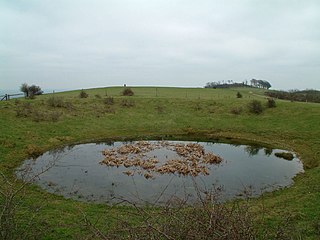 W
WA dew pond is an artificial pond usually sited on the top of a hill, intended for watering livestock. Dew ponds are used in areas where a natural supply of surface water may not be readily available. The name dew pond is first found in the Journal of the Royal Agricultural Society in 1865. Despite the name, their primary source of water is believed to be rainfall rather than dew or mist.
 W
WA ditch is a small to moderate divot created to channel water. A ditch can be used for drainage, to drain water from low-lying areas, alongside roadways or fields, or to channel water from a more distant source for plant irrigation. Ditches are commonly seen around farmland, especially in areas that have required drainage, such as The Fens in eastern England and much of the Netherlands.
 W
WA double check valve or double check assembly (DCA) is a backflow prevention device designed to protect water supplies from contamination. It is different from the two-way check valves used in air brake systems on heavy trucks which select from the highest pressure source.
 W
WDrip irrigation is a type of micro-irrigation system that has the potential to save water and nutrients by allowing water to drip slowly to the roots of plants, either from above the soil surface or buried below the surface. The goal is to place water directly into the root zone and minimize evaporation. Drip irrigation systems distribute water through a network of valves, pipes, tubing, and emitters. Depending on how well designed, installed, maintained, and operated it is, a drip irrigation system can be more efficient than other types of irrigation systems, such as surface irrigation or sprinkler irrigation.
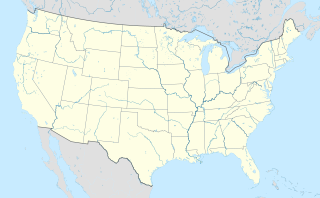 W
WThe Elephant Butte Irrigation District is a 6,870 acres (27.8 km2) historic district in New Mexico and Texas which was listed on the National Register of Historic Places in 1997. The listing included three contributing buildings and 214 contributing structures, in Doña Ana County, New Mexico, Sierra County, New Mexico and El Paso County, Texas..
 W
WThe environmental impacts of irrigation relate to the changes in quantity and quality of soil and water as a result of irrigation and the effects on natural and social conditions in river basins and downstream of an irrigation scheme. The impacts stem from the altered hydrological conditions caused by the installation and operation of the irrigation scheme.
 W
WEvapotranspiration (ET) is the sum of water evaporation and transpiration from a surface area to the atmosphere. Evaporation accounts for the movement of water to the air from sources such as the soil, canopy interception, and water bodies. Transpiration accounts for the movement of water within a plant and the subsequent exit of water as vapor through stomata in its leaves in vascular plants and phyllids in non-vascular plants. A plant that contributes to evapotranspiration is called an evapotranspirator. Evapotranspiration is an important part of the water cycle.
 W
WFertigation is the injection of fertilizers, used for soil amendments, water amendments and other water-soluble products into an irrigation system.
 W
WGardena GmbH, based in Ulm, Germany, is a manufacturer of gardening tools and has been a subsidiary of the Swedish Husqvarna Group since 2007. With an annual sales of 8,343 million Swedish krona in 2019, Gardena is the European market leader.
 W
WIce Stupa is a form of glacier grafting technique that creates artificial glaciers, used for storing winter water in the form of conical shaped ice heaps. During summer, when water is scarce, the Ice Stupa melts to increase water supply for crops. Ice Stupa was invented by Sonam Wangchuk in Ladakh (India) and the project is undertaken by the NGO Students' Educational and Cultural Movement of Ladakh. Launched in October 2013, the test project started in January 2014 under the project name The Ice Stupa project. On 15 November 2016, Sonam Wangchuk was awarded the Rolex Awards for Enterprise for his work on Ice Stupa.
 W
WAn impact sprinkler is a type of irrigation sprinkler in which the sprinkler head, driven in a circular motion by the force of the outgoing water, pivots on a bearing on top of its threaded attachment nut. Invented in 1933 by Orton Englehart, it quickly found widespread use. Though it has in many situations been replaced by gear-driven "rotor heads", many varieties of impact sprinkler remain in use.
 W
WIrrigation in viticulture is the process of applying extra water in the cultivation of grapevines. It is considered both controversial and essential to wine production. In the physiology of the grapevine, the amount of available water affects photosynthesis and hence growth, as well as the development of grape berries. While climate and humidity play important roles, a typical grape vine needs 25-35 inches of water a year, occurring during the spring and summer months of the growing season, to avoid stress. A vine that does not receive the necessary amount of water will have its growth altered in a number of ways; some effects of water stress are considered desirable by wine grape growers.
 W
WAn irrigation sprinkler is a device used to irrigate agricultural crops, lawns, landscapes, golf courses, and other areas. They are also used for cooling and for the control of airborne dust. Sprinkler irrigation is the method of applying water in a controlled manner in way similar to rainfall. The water is distributed through a network that may consist of pumps, valves, pipes, and sprinklers.
 W
WLift irrigation is a method of irrigation in which water is not transported by natural flow, but is lifted with pumps or surge pools etc.
 W
WMicro-irrigation, also called localized irrigation, low volume irrigation, low-flow irrigation, or trickle irrigation, is an irrigation method with lower pressure and flow than a traditional sprinkler system. Low volume irrigation is used in agriculture for row crops, orchards, and vineyards. It is also used in horticulture in wholesale nurseries, in landscaping for civic, commercial, and private landscapes and gardens, and in the science and practice of restoration ecology and environmental remediation.
 W
WMajor irrigation project is a classification of irrigation projects used in India. A project with a cultivable command area of more than 10000 hectares is classified as a major irrigation project. Before the Fifth Five-Year Plan, irrigation schemes were classified on the basis of investments needed to implement the scheme. Since the Fifth Five-Year Plan, India has adopted the command area-based system of classification.
 W
WA media filter is a type of filter that uses a bed of sand, peat, shredded tires, foam, crushed glass, geo-textile fabric, anthracite, crushed granite or other material to filter water for drinking, swimming pools, aquaculture, irrigation, stormwater management, oil and gas operations, and other applications.
 W
WA noria is a hydropowered machine used to lift water into a small aqueduct, either for the purpose of irrigation or to supply water to cities and villages.
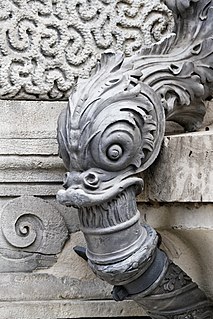 W
WA pipe is a tubular section or hollow cylinder, usually but not necessarily of circular cross-section, used mainly to convey substances which can flow — liquids and gases (fluids), slurries, powders and masses of small solids. It can also be used for structural applications; hollow pipe is far stiffer per unit weight than solid members.
 W
WPulse drip irrigation is an experimental irrigation technique primarily used with drip irrigation. Maintaining a high level of soil moisture for germination of seed is one reason this technique may be used.
 W
WA qanat or kariz, is a system for transporting water from an aquifer or water well to the surface, through an underground aqueduct. Constructed in Iran, Iraq and numerous other societies, this is an ancient system of water supply which allows water to be transported over long distances in hot dry climates without loss of much of the water to evaporation. The system has the advantage of being resistant to natural disasters such as earthquakes and floods, and to deliberate destruction in war. Furthermore, it is almost insensitive to the levels of precipitation, delivering a flow with only gradual variations from wet to dry years.
 W
WRain Clox was the trade name given to a series of electromechanical irrigation controllers produced by the Rain Bird Corporation from 1962 to the late 2000s (decade), and were largely responsible for giving rise to the widespread use of automatic irrigation. The first model was the ME11AB, capable of running 11 stations on two schedules. A scaled-down residential model, the RC-8, was formally introduced in 1968 and was marketed as the "first appliance for the garden". The Los Angeles Times reported in 1967 that architects incorporated the RC-8 into a suburban housing development in Glendale, California, planning on adding the cost of the system to the mortgage. The controllers were used in controlled experiments of swine waste lagoon systems. The product line would later range from compact 3-station mechanical units to 23-station multi-program devices.
 W
WA rain sensor or rain switch is a switching device activated by rainfall. There are two main applications for rain sensors. The first is a water conservation device connected to an automatic irrigation system that causes the system to shut down in the event of rainfall.
 W
WRainwater harvesting (RWH) is the collection and storage of rain, rather than allowing it to run off. Rainwater is collected from a roof-like surface and redirected to a tank, cistern, deep pit, aquifer, or a reservoir with percolation. Dew and fog can also be collected with nets or other tools. Rainwater harvesting differs from stormwater harvesting as the runoff is collected from roofs, rather than creeks, drains, roads, or any other land surfaces. Its uses include watering gardens, livestock, irrigation, domestic use with proper treatment, and domestic heating. The harvested water can also be committed to longer-term storage or groundwater recharge.
 W
WWater reclamation is the process of converting wastewater into water that can be reused for other purposes. Reuse may include irrigation of gardens and agricultural fields or replenishing surface water and groundwater. Reused water may also be directed toward fulfilling certain needs in residences, businesses, and industry, and could even be treated to reach drinking water standards. This last option is called either "direct potable reuse" or "indirect potable" reuse, depending on the approach used.
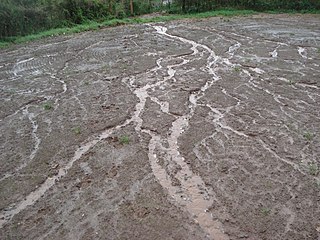 W
WIn hillslope geomorphology, a rill is a shallow channel cut into soil by the erosive action of flowing water. Similar but smaller incised channels are known as microrills; larger incised channels are known as gullies.
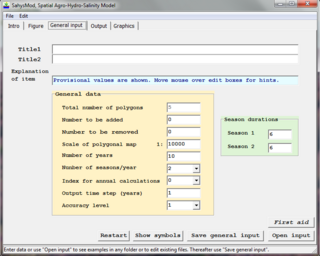 W
WSahysMod is a computer program for the prediction of the salinity of soil moisture, groundwater and drainage water, the depth of the watertable, and the drain discharge in irrigated agricultural lands, using different hydrogeologic and aquifer conditions, varying water management options, including the use of ground water for irrigation, and several crop rotation schedules, whereby the spatial variations are accounted for through a network of polygons.
 W
WSaltMod is computer program for the prediction of the salinity of soil moisture, groundwater and drainage water, the depth of the watertable, and the drain discharge (hydrology) in irrigated agricultural lands, using different (geo)hydrologic conditions, varying water management options, including the use of ground water for irrigation, and several cropping rotation schedules. The water management options include irrigation, drainage, and the use of subsurface drainage water from pipe drains, ditches or wells for irrigation.
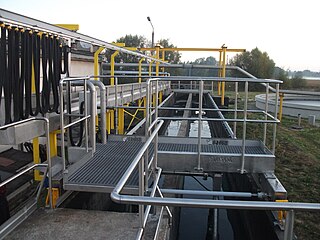 W
WA sand separator is a device that separates sand or other solids from water.
 W
WA settling basin, settling pond or decant pond is an earthen or concrete structure using sedimentation to remove settleable matter and turbidity from wastewater. The basins are used to control water pollution in diverse industries such as agriculture, aquaculture, and mining. Turbidity is an optical property of water caused by scattering of light by material suspended in that water. Although turbidity often varies directly with weight or volumetric measurements of settleable matter, correlation is complicated by variations in size, shape, refractive index, and specific gravity of suspended matter. Settling ponds may be ineffective at reducing turbidity caused by small particles with specific gravity low enough to be suspended by Brownian motion.
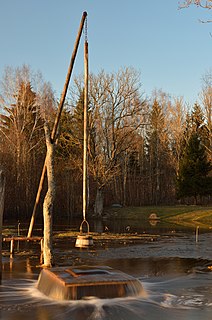 W
WA shadoof or shaduf is an irrigation tool. It is highly efficient, and has been known since 3000 BCE.
 W
WSoil moisture sensors measure the volumetric water content in soil. Since the direct gravimetric measurement of free soil moisture requires removing, drying, and weighing of a sample, soil moisture sensors measure the volumetric water content indirectly by using some other property of the soil, such as electrical resistance, dielectric constant, or interaction with neutrons, as a proxy for the moisture content.
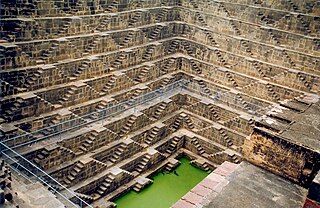 W
WStepwells are wells or ponds in which the water is reached by descending a set of steps to the water level. They may be multi-storied with a bullock turning a water wheel to raise the well water to the first or second floor. They are most common in western India and are also found in the other more arid regions of the Indian subcontinent, extending into Pakistan. The construction of stepwells is mainly utilitarian, though they may include embellishments of architectural significance, and be temple tanks.
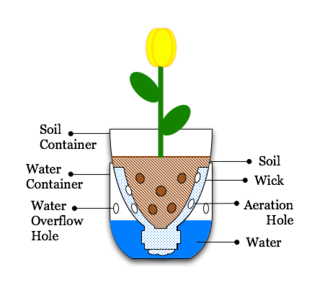 W
WSub-irrigated planter (SIP) is a generic name for a special type of planting box used in container gardening and commercial landscaping. A SIP is any method of watering plants where the water is introduced from the bottom, allowing the water to soak upwards to the plant through capillary action. It is possible to automate the watering and thus SIPs are popular with professional landscapers in buildings or urban settings. Commercialized versions of a Sub-irrigated planter condenses humidity from the environment and feed it directly into the plants' roots. SIPs are available as commercial products or as do-it-yourself projects made from plastic buckets, boxes or storage totes. One of the disadvantages of such closed systems is that soluble salts cannot be flushed into the lower soil profile and build up over time.
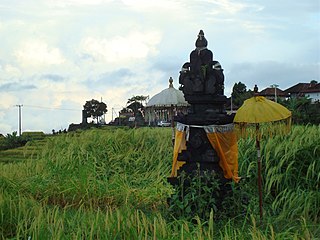 W
WSubak is the water management (irrigation) system for paddy fields on Bali island, Indonesia which was developed in the 9th century. For the Balinese, irrigation is not simply providing water for the plant's roots, but water is used to construct a complex, pulsed artificial ecosystem. The system consists of five terraced rice fields and water temples covering nearly 20,000 hectares. The temples are the main focus of this cooperative water management, known as subak.
 W
WA submersible pump is a device which has a hermetically sealed motor close-coupled to the pump body. The whole assembly is submerged in the fluid to be pumped. The main advantage of this type of pump is that it prevents pump cavitation, a problem associated with a high elevation difference between pump and the fluid surface. Submersible pumps push fluid to the surface as opposed to jet pumps which create a vacuum and rely upon atmospheric pressure. Submersibles use pressurised fluid from the surface to drive a hydraulic motor downhole, rather than an electric motor, and are used in heavy oil applications with heated water as the motive fluid.
 W
WSurface irrigation is where water is applied and distributed over the soil surface by gravity. It is by far the most common form of irrigation throughout the world and has been practiced in many areas virtually unchanged for thousands of years.
 W
WSurface runoff is the flow of water occurring on the ground surface when excess rainwater, stormwater, meltwater, or other sources, can no longer sufficiently rapidly infiltrate in the soil. This can occur when the soil is saturated by water to its full capacity, and that the rain arrives more quickly than the soil can absorb it. Surface runoff often occurs because impervious areas do not allow water to soak into the ground. Surface runoff is a major component of the water cycle. It is the primary agent of soil erosion by water. The land area producing runoff that drains to a common point is called a drainage basin.
 W
WA tap is a valve controlling the release of a liquid or gas.
 W
WA tensiometer in soil science is a measuring instrument used to determine the matric water potential in the vadose zone. This device typically consists of a glass or plastic tube with a porous ceramic cup and is filled with water. The top of the tube has either a built-in vacuum gauge or a rubber cap used with a portable puncture tensiometer instrument, which uses a hypodermic needle to measure the pressure inside the tensiometer. The tensiometer is buried in the soil, and a hand pump is used to pull a partial vacuum. As water is pulled out of the soil by plants and evaporation, the vacuum inside the tube increases. When the soil is wetted flow can also occur in the reverse direction: as water is added to the soil, the vacuum inside the tube pulls moisture from the soil and decreases. When the water pressure in the tensiometer is determined to be in equilibrium with the water pressure in the soil, the tensiometer gauge reading represents the matric potential of the soil.
 W
WTerracotta, terra cotta, or terra-cotta, a type of earthenware, is a clay-based unglazed or glazed ceramic, where the fired body is porous. Terracotta is the term normally used for sculpture made in earthenware, and also for various practical uses including vessels, water and waste water pipes, roofing tiles, bricks, and surface embellishment in building construction. The term is also used to refer to the natural brownish orange color of most terracotta.
 W
WTurpan Karez Paradise is a museum featuring Turpan's karez water management system, in Turpan, a city in the Turpan Depression, Xinjiang, China. The karez is a vertical tunnel system connecting wells developed by the Turpan people to irrigate their arid land. The word karez means "well" in the local Uyghur language. Visitors to the museum can learn about the underground irrigation system in the desert area, and see the karez system in operation.
 W
WWarabandi system is a rotational water allocation system which can fulfill the requirement of equality. Warabandi system helping farmer can be allocated the same volume of water after the regular rotation of water as the operation got three distribution procedure during delivery with canals flows with piped water. Warabandi system got two primary purposes, high efficiency on water supply and equity on water usage.
 W
WA water filter removes impurities by lowering contamination of water using a fine physical barrier, a chemical process, or a biological process. Filters cleanse water to different extents for purposes such as providing agricultural irrigation, accessible drinking water, public and private aquariums, and the safe use of ponds and swimming pools.
 W
WHydraulic shock is a pressure surge or wave caused when a fluid, usually a liquid but sometimes also a gas, in motion is forced to stop or change direction suddenly; a momentum change. This phenomenon commonly occurs when a valve closes suddenly at an end of a pipeline system, and a pressure wave propagates in the pipe.
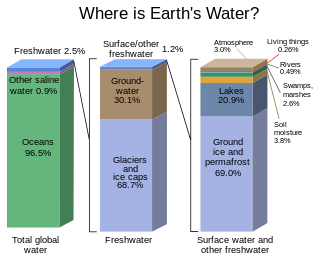 W
WWater resources are natural resources of water that are potentially useful. Uses of water include agricultural, industrial, household, recreational and environmental activities. All living things require water to grow and reproduce.
 W
WThe water table is the upper surface of the zone of saturation. The zone of saturation is where the pores and fractures of the ground are saturated with water.
 W
WA water timer is an electromechanical device that, when placed on a water line, increases or decreases the water flow through the use of an electro-mechanically actuated ball valve or embedded (solenoid) valve. It is used in conjunction with irrigation sprinklers to form an automated or non-automated sprinkler system, capable of administering precise amounts of water, at a regular basis. A water flow timer using a ball valve contains an electric motor with gears to stop or start the water flow by turning a perforated ball within the water flow line. The gearbox in a ball valve timer makes a rumbling sound when actuated. The solenoid type switching timers contain a solenoid that relieves pressure on a diaphragm in the water-flow tube or moves a stopper into the water flow area to regulate flow. The solenoid type uses no gears and makes a tapping sound when the solenoid is activated. Battery powered garden hose timers are the most commonly seen water timers and are seen in two types, the ball valve timer that is actuated by a motor with gears, and the diaphragm timer that is actuated by a solenoid. The solenoid/diaphragm timer uses more battery power throughout the "on" cycle because the solenoid must be actuated the entire time that the water flow is "on". The ball valve timer using the motor and gear actuator only uses more battery power during the few seconds that motor is used to turn the water flow "on" or "off".
 W
WA watering can is a portable container, usually with a handle and a funnel, used to water plants by hand. It has been in use since at least 79 A.D. and has since seen many improvements in design. Apart from watering plants, it has varied uses, as it is a fairly versatile tool.
 W
WWaterlogging is the saturation of soil with water. Soil may be regarded as waterlogged when it is nearly saturated with water much of the time such that its air phase is restricted and anaerobic conditions prevail. In extreme cases of prolonged waterlogging, anaerobiosis occurs, the roots of mesophytes suffer, and the subsurface reducing atmosphere leads to such processes as denitrification, methanogenesis, and the reduction of iron and manganese oxides.